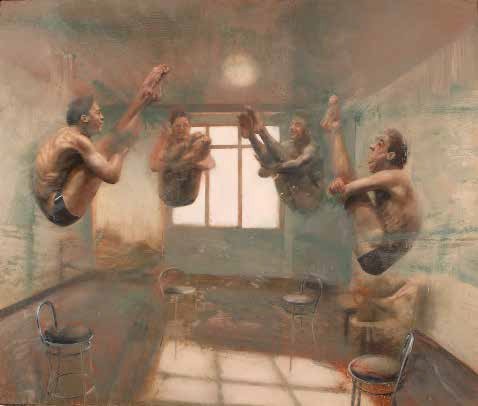Nuova Wave
A selection of contemporary artists out of Italy to note
Present times have gifted us with some wonderful visual surprises. Gone are the days when the aesthetic quality seemed cumbersome, with the light of center stage brightly shining on the process behind the work – on the painting that intensifies and develops the representation, the expressive styles that transcend the uncertainties of postmodernism. Great artists search for the specific style that sets them apart from all others, an autonomy which frees them from pre-existing forms of art and any set-in-stone formula. Today it means to take from the past without overdoing it, so that the final shape is a juxtaposition of its origins and not just a reminder of the similarities to its inspirations. The work accumulates and synthesizes, wiping away those memories in a sense that is classical but arises from a contemporary mix. After all, you are following the anthropological evolution of the web, the new social soul, living consciousness that affects actions and determines our position in the world. Here the most interesting artists reflect the process of the digital language, developing ideas with a thought method similar to that of computers. Hence the revival of a hybrid painting that is unclassifiable, neat and tidy in appearance but in reality unsettling, dramatic, as unstable as the society in which we live. A hyper-realistic approach to painting, with excessive expressionism or obsessive perfectionism. In reality, a black and white method with no grey areas to connect genres and archetypes fills a passionate and powerful framework, alive in its transformation, “bad” to the right extent.
STEFANO ABBIATI
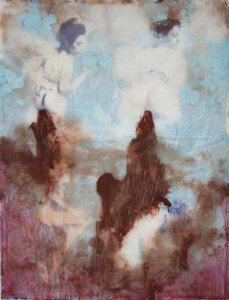
(Milan, 1979) scours the photographic universe of the web, the magazines and blogs, paper and digital archives, seeking that certain something held in the semantic ambiguity of the image, that touch of infectious insanity pulsing beneath the surface of “normality”. The digitalized photographs are the starting point, the root of the artist’s painting process. The finished image seems immersed in a cloudy mist, floating under water, in a type of geological stratification that transports the image away from pure realism. The work brings the essence of life into sharp focus before it all then dissolves, to the point where the work resembles a foggy trip down memory lane. A cerebral painting, like a mind that processes, records, overlaps, fixes, alters, removes…
SILVIA ARGIOLAS
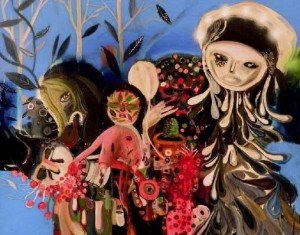
(Cagliari, 1977) invents scenarios combining the fairy tatle with the horror style of Maurice Sendak, populated by anthropomorphic creatures, struggling with the rawest essence of primordial life. A playful appearance hides links with archaic rituals, Pagan cultures, regional traditions along the dramatic thread that connects life and death. To do so, the artist paints in a spirited and expressive manner, bulimic in the rhythm of color, but without losing control of the essence, the details, the moods. You feel an emotional tension that accompanies every story, every character, every action, confirming the symbolic attitude that balances the emotions within the work. The artist’s relationship with the Sardinian culture is hinted at, filtered like a coded message through her gazes, confirming in a technological world how valuable one’s roots still are.
FRANCESCO IRNEM

(Rome, 1981) creates his paintings with meticulous attention to the process behind the work. He starts with an idea that man is bound to mass media, architecture, to contemporary landscape. This idea becomes portraits in which some fragments are missing, as if stripping away a layer of paint to reveal the hidden beauty underneath; hence the rationale of blurring some parts of buildings, to highlight the complexity of the vision and the value of conceptual architecture; hence the pieces of newspapers cut and pasted together to conjure up new images, faces and words. Irnem does everything in the style of Gerhard Richter, where perfectionism touches and surpasses its digital appearance, leaving the work to linger in its power of pictorial appeal and creativity, its timeless quality.
MAURO MAUGLIANI

(Tivoli, 1967) uses a technical perfectionism, capturing the soul of his protagonists with a frontal framing technique. His portraits are hyper-realistic representations of a particular human nature, achieved through methodical processes that amaze and catch you off-guard. The paradox is all within the portrayed subjects, clearly “photographic” yet anomalies, extremes, stripped naked to a brush that personifies the baring of the soul. Herein lies the value of hyperrealism as an emotional instrument, a forceful moral activator that challenges us to look in detail at diversity, old age, the flesh, the repressed beauty. But above all, Maugliani mixes “beautiful” and “ugly” without making any distinction, without stamps of judgment, without an established hierarchy. An image literally representing an open heart.
ALESSANDRO PASSARO

(Mesa (BR), 1974) has a beautiful synthesis with pictorial materials. His is a dirty, but controlled, brush, where the dense and high color builds the scenes and their emotional poignancy. There are figures, alone or with others, put in slightly unorthodox positions but clearly recognizable. The depth of perception focuses on the context in which we find the subject, as if the internal and external become comingled beyond realism. You see a person seated and understand that the chair on a floor of water is not normal. See strange contortions of the body, anomalous objects, cameras, fairytale characters, bits of blue sky … the sum of the elements breaks the symbolic linearity and organizes a world, the result of an artist who designs the bare bones of a cerebral journey with explosive results.
NICOLA PUCCI
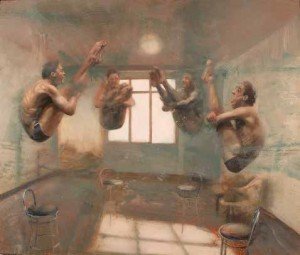
(Palermo, 1966) takes from drawings or photographs, using them as foundations which give a painting body (the form), soul (the emotional key, more and more relevant in recent times) and brain (the conceptual signs resulting from aesthetic process). The artist creates plausible yet absurd scenes, containing people committing ritual actions in closed rooms. Imagine a man seated and a screaming monkey that are doing something unusual and touching. Or four divers around a tiny pool inside a room. Two scenes that explain Pucci’s flair for the absurdity in the realism, a moment before the scene becomes surreal. A look across the dynamics of the soul, on the symbolic displacement, on the value of the photographic here and now. A painting that re-designs portraits and their aesthetic codes.
GIULIANO SALE

(Cagliari, 1977) silently assails you, capturing your emotions through the purity of an archaic painting, ageless in its empathic essence. The concepts are taken from Carrà’s evocative landscapes, from symbolism which has maintained the historic framework of the twentieth century. From here Sale’s landscapes are reborn, his world nocturnal and enlightening, where the air pulses with desolation and failed expectations. People and places intersect in his painted stories, through mysterious glances and calm sea coves, small houses and deserted countrysides, solitary trees and threatening skies. The silence is overpowering, but is a deafening silence, fallible, destined to be imminently shattered. We decide what that will be, leaving the questioning spirit of the canvas to the fates. Giving the painting back the moral compass of its conscience.
ALESSANDRO SCARABELLO
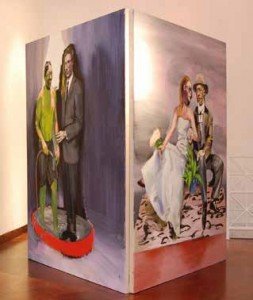
(Rome, 1979) creates scenes in a theatrical style, as if they were Baconian scenes in which the soul expresses anxiety, the turbulence behind the focused postures, the scarce props, the realistic but expressive colors. His work defies a thematic order and cannot be pigeonholed; yet it all seems understandable: we see some figures in centerstage, posing for a portrait in a nearly empty room. Anyone would think this a typically posed portrait, in effect the scene reminds us of an aristocratic full-length stance; but nothing is as it seems, focus on the faces and you will understand that it shows the dark side of power, the hidden obedience, quiet fierceness, the related violence. A truly fierce painting.
Gianluca Marziani is the Art Columnist for the Italian Journal
